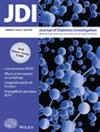A clinical model for highly accurate prediction of blood glucose depression after continuous intravenous insulin therapy in hyperglycemic emergencies, a multicenter retrospective cohort study
Abstract
Background
Hyperglycemic emergencies are broadly classified into diabetic ketoacidosis and hyperosmotic hyperglycemic state. The purpose of this study was to develop a clinical model for predicting treatment of hyperglycemic emergencies.
Methods
This study is a multicenter, retrospective cohort study. We used information on patients admitted to four medical institutions for treatment for hyperglycemic emergencies by diabetologists between April 1, 2010, and March 31, 2024, as the machine learning's training data. Multiple regression analysis was performed to find parameters that correlated with the difference between blood glucose levels before and after treatment initiation (ΔGlu), and a gradient boosting decision tree (GBDT) was created to predict ΔGlu.
Results
Patients with type 1 diabetes (n = 47) and type 2 diabetes (n = 116) were included in the analysis of this study. We created a GBDT model using the following parameters as features: blood glucose level at the start of continuous intravenous insulin therapy, bicarbonate concentration, insulin flow rate, time elapsed since the start of continuous insulin therapy, and drip flow, which are important parameters for continuous intravenous insulin therapy for hyperglycemic emergencies. As a result, the correlation coefficient between predicted ΔGlu and actual ΔGlu was 0.83, showing a strong positive correlation.
Conclusions
A GBDT model was developed to predict treatment after continuous intravenous insulin therapy using several variables during emergency care of patients with hyperglycemic emergencies. It is hoped that the application of this GBDT will allow appropriate provision of initial treatment, especially in nonspecialized medical facilities.


 求助内容:
求助内容: 应助结果提醒方式:
应助结果提醒方式:


